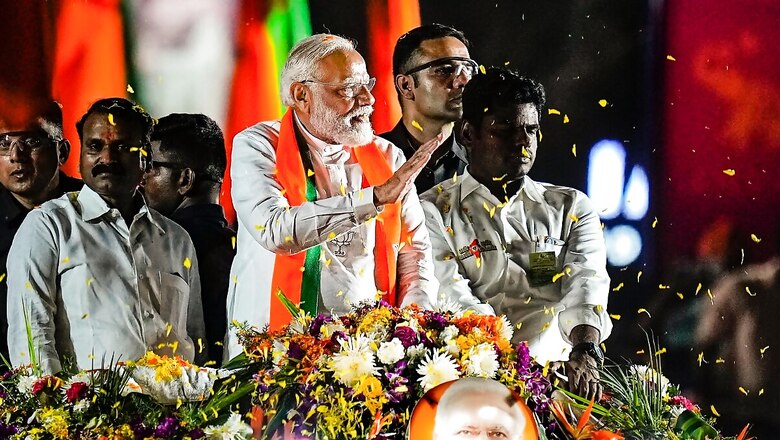
views
The most critical aspect of inclusive growth is financial inclusion which has been a core agenda and achievement of the Modi government.
Financial inclusion in India was as low as 35 per cent of adults possessing bank accounts till 2011, which is, well below the average of other emerging market economies. Even 12 per cent of adults saved or 8 per cent borrowed from a financial institution. Cash was used extensively, with currency in circulation at about 12 per cent of the GDP, even though holding cash carried a high opportunity cost and the availability of ATMs was just 21 per 100,000 adults (IMF Financial Access Survey).
A major policy turn came in this relation in 2014, with the formation of the Modi government at the Centre. Though India was not the first and only country to adopt a digitally verifiable unique identity system, what set the nation apart was the large scale and low unit costs of operating the program, which enabled its billion-plus population to get enrolled in the program and quickly acquire a national ID that could be used in all aspects of economic life, including faster access to financial services.
Financial inclusion is the delivery of financial facilities at affordable costs to individuals belonging to disadvantaged and low-income groups. It opens a universal doorway to a myriad of financial services at a minimal cost. In 2020, the RBI released its National Strategy for Financial Inclusion 2019–24, which laid out its objectives for financial inclusion policies in India. The strategy aims to provide universal access to financial services—savings, credit, insurance, and pension products—to every eligible adult. It highlights the use of technology and adoption of a multi-stakeholder approach for achieving its financial inclusion goals and notes that the bank-led model of financial inclusion adopted by the RBI through the issuance of differentiated banking licenses (small finance banks and payments banks) is helping bridge the gap in last-mile connectivity.
To enhance the financial inclusion spectrum, the Modi government in the last 10 years has rolled out several schemes. Needless to say, these schemes launched after rigorous planning and research have brought drastic transformations in relation to financial inclusion. Some of the financial inclusion schemes are PMJDY (Pradhan Mantri Jan Dhan Yojana), APY (Atal Pension Yojana), PMVVY (Pradhan Mantri Vaya Vandana Yojana), PMMY (Pradhan Mantri Mudra Yojana), PMSBY (Pradhan Mantri Suraksha Bima Yojana), Sukanya Samriddhi Yojana, Jeevan Suraksha Bandhan Yojana, CEGS (Credit Enhancement Guarantee Scheme) for SCs, venture capital fund for SCs under the social sector initiatives, VPBY (Varishtha Pension Bima Yojana), KCC, so on and so forth.
The biggest structural shift in access to finance came with the rollout of the Pradhan Mantri Jan Dhan Yojana (PMJDY) scheme in August 2014. This was an ambitious financial development policy to provide bank accounts to all households in India and convenient access to savings accounts through a debit card (called RuPay) and mobile banking. A variety of features distinguished this financial inclusion program from previous and similar programs. These include a no-frills, zero-balance account with a debit card, access to mobile banking for funds transfer, overdraft facilities, and built-in basic life insurance coverage for all account holders. Bank accounts under this scheme could be opened using the Aadhaar ID and subsequently linked to it for the transfer of government benefits.
In just one year after its launch, 180 million Indians, about 15 per cent of the population, had opened accounts as part of the program, and 404 million had accounts by 2020 (30 per cent), with 86 per cent of the accounts still operative and 73 per cent of the account holders using the RuPay debit card. Moreover, about 15 per cent of PMJDY account holders receive direct benefit transfers from the Indian government under various schemes. At present, more than 50 crore beneficiaries bank under PMJDY since its inception. Today, total deposit
balances under the PMJDY accounts stand at Rs 2,03,505 crore.
Around 56 per cent of Jan Dhan account holders are women and around 67 per cent of Jan Dhan accounts are in rural and semi-urban areas, thus narrowing the gender gap and rural-urban divide in relation to financial access. 33.98 crore RuPay cards have been issued to PMJDY account holders. India has already and will benefit much from broadening access to finance while maintaining financial stability. These schemes, in addition to enhancing individual opportunities, have positive macroeconomic effects. The linking of PMJDY bank accounts with Aadhaar and mobile phone numbers, called the JAM trinity, provides the foundational digital infrastructure for increasing digital financial inclusion. Affordability and access to smartphones have improved significantly in recent years.
Demonetisation led to the first surge in the use of digital payments, particularly mobile money. On November 8, 2016, the Government of India announced the demonetisation of major bank currencies from circulation, effectively withdrawing 86 per cent of currency from circulation and constraining the use of cash. While demonetisation’s major objective was addressing corruption and counterfeit bills and increasing the formal tax base, it effectively resulted in a spike in the use of digital payment instruments. The launch of interoperable payments, through the Unified Payments Interface (UPI) in 2016, played a major role in sustaining the use of digital financial services.
The UPI allows instant and real-time interbank transactions through various payment platforms, and enables banks and non-banks to operate with each other, resulting in increased business formalisation and digital acceptance. The GST regime rolled out in 2017 too has its share of these two outcomes. IMF research shows that financial inclusion supports growth and lowers inequality, and provided the financial sector is well regulated, it supports financial stability. A successful rolling out of the GST regime has enabled one nation, one market, and one tax, eliminating the cascading effects of indirect taxes at various levels of production and consumption.
Modi’s India: A Self-reliant One
Atmanirbhar Bharat Abhiyaan is the mission started by the government on May 13, 2020, towards making India self-reliant. Prime Minister Narendra Modi announced an economic package of Rs 20 lakh crore to aid and support the country in times of the pandemic. It is focused on five components – economy, infrastructure, systems, vibrant demography and demand, creating distinctive competitive advantages. The conceptualisation of a developed independent country can be painted on the canvas of Amrit Kaal—the 25 years from 2022 leading up to 2047. An Atmanirbhar Bharat strengthens the foundations of each of these.
The most common way to think about ‘Viksit Bharat’ is the economic aspect, with international organisations like the World Bank prescribing the per-capita gross national income threshold to cross, to be labelled a developed country. The significance of the aspiration for atmanirbharta for a strong economic foundation and a robust domestic market cannot be overstated. Creating home-grown products, formulation of fit-for-context economic and industrial policies and assessment of strengths in specific sectors will enhance India’s ability to shape the global business flows and will underpin India’s robust growth and success story initiated by PM Modi.
Internal Security
Post-independence, India faced severe jolts of terrorism, religious extremism, and left-wing violence on the internal security front, resulting in innumerable deaths of civilians and security personnel. Defence is a complex security-development matrix and is an integral feature of a country’s security issues. Both security and development are essentially interlinked as multiple traditional and non-traditional threats work simultaneously to security.
The government, since 2014, has adopted the policy of zero tolerance and made a strategy to completely eliminate terrorism along with a whole-of-government approach towards growth and development in such areas with special emphasis. The government has not only considered it necessary to deal with terrorism but also dealt with blowing up its ecosystem. Due to its two-pronged policy, the Modi government has achieved huge success in these three hotspots.
Union Home Minister Amit Shah said that the government has achieved this success due to the whole of government approach, cooperation and coordination between all the agencies, strong legal framework, legal framework being created for justice delivery, technology-based database, and knowledge sharing. The multi-agency approach, which has been adopted as a different policy in each theatre sector, has achieved unexpected success in all three hotspots. Between 2004 and 2014, the number of violent incidents was 33,000, while between 2014 and 2023, it has come down by 62 per cent to 12,466. The total number of deaths among civilians and security forces has declined by 72 per cent from 11,900 to 3,276.
The abolition of Article 370 and 35A, which was fuelling separatism in Jammu and Kashmir for years, is a great achievement of the Modi government. Through this, the people of Kashmir got their due constitutional rights and today, there are more than 30,000 local representatives. Apart from this, more than 100 laws of the country, which were not applicable in Jammu & Kashmir, have been implemented for the people of Kashmir by removing Article 370.
During the last 10 years, nine peace agreements in the Northeast have been signed, under which more than 9,000 youth have given up arms and come into the mainstream. The recent peace pact with ULFA presents a significant opportunity for peace and development in Assam. The Modi government has worked to resolve border, racial, and religious disputes in the Northeast. Further streamlined development and peace have resulted in the withdrawal of the AFSPA and the Preventive Detention Law has been removed from more than 70 per cent of the Northeast region. The Modi government has spent Rs 14 lakh crore on infrastructure development in the Northeast in just 10 years between 2014 and 2024. Today, rail and air connectivity in all the states of the Northeast is bringing new prospects of development and connectivity with the rest of the country.
In the Left-Wing extremism-affected areas, the Union government has launched many development and welfare schemes at the grassroots level under the whole-of-government approach, which drove the poor tribal people away from the leftist extremists, thus, eroding the popular support base of the extremists. The Modi government has reduced 75 per cent of violence by strengthening the security arrangements in the entire Naxal conflict zone.
Foreign Policy
Foreign policy has been one of the unexpected areas of focus for the Modi government. With a strong emphasis on the ‘India First’ approach, several structural shifts like a departure from India’s non-aligned international position, India’s closer engagement with the West, particularly the USA, usage of soft power with gusto and of late, becoming the voice of the Global South. In the ORF Foreign Policy Survey 2023, it has been found that about 86 per cent of people appreciated the foreign policy of India. With Covid acting as a global scourge and two unanticipated international conflagrations in quick succession, i.e., the Russo-Ukraine war and the Israel-Hamas conflict taking place, PM Modi acted as an exceptional navigator of India’s diplomacy. Some other unsettling developments during this period included the increasingly aggressive behaviour of China in the East China Sea against Japan and Taiwan.
The successful organisation of G20 and the unanimously passed Delhi Declaration have put India’s positive image before the world in terms of diplomatic success. The G20 summit succeeded in spreading India’s basic mantra of ‘Vasudhaiva Kutumbakam’ to the whole world through the overarching theme of ‘One Earth, One Family, One Future’, which encapsulates India’s vision of fostering unity and equality, transcending the traditional distinctions between developed and developing nations. The Summit became the ambassador of India’s cultural heritage and prosperity in the whole world. The Summit, along with the simultaneous bilateral and plurilateral meetings, reflected India’s autonomous foreign policy stance and the nature of its relationships with key international actors, its increasing global clout, being the voice of the Global South, and its efforts to effectuate a revived multilateralism.
Modi’s two successful consecutive tenures as the Prime Minister of Bharat show how effectively he has upheld the Rājadharma as enunciated by the early Indian scriptures and has laid the foundations of a Ram Rajya, which leaves us with no meaningful alternative to his leadership. Modi 3.0 with a 400+ majority is not only inevitable but equally legitimate, considering the all-round peace, stability, development and inclusivity the Modi government has successfully brought in.
Concluded
Here’s the first part of the series.
The author is a senior faculty in the Department of History, ARSD College, University of Delhi. Views expressed in the above piece are personal and solely that of the author. They do not necessarily reflect News18’s views.
















Comments
0 comment